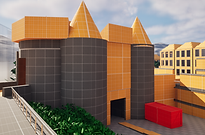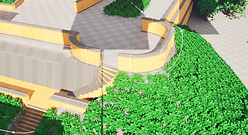
I'm a great enjoyer of FPS games. I spent thousands of hours playing CS, Apex, Battlefield, and Overwatch because of challenge and teamwork. For me, joining my old friend group and climbing the ladder (and sometimes falling from it) is one of the most engaging ways to have fun.
The game I'm currently playing the most is The Finals - known for its destruction mechanic and chaotic gameplay. The maps in The Finals often replicate real locations: they are vast and rich, which makes them hard to get tired of, always leaving with more to crumble down.
Having gained some experience making games, I attempted to create a blockout for one such multiplayer map. I picked Warsaw for it since it's a city I lived in the longest and chose its center for the map - the Old Town.
Team: 1 person Tools: Unreal, Google Earth Roles: Design, Research Duration: 2 Weeks



The Resemblance
Warsaw's Old Town is a place that lived through fire and bombs, so, when visiting, it may feel like its buildings are randomly mashed together. Reconstruction often combined different architectural styles and borrowed from the medieval age that greatly shaped the initial look of the city. These differences are not something I had the time to replicate in this project - I mainly focused on the cohesion of the space and large-scale decision-making.
I avoided repetition and attempted to make each point of interest feel unique. For example, the middle column of buildings is shortened and isn't as wide. The section at the top of the photo of the city is almost entirely removed since the courtyards below already provide similar space for the gameplay.
Perhaps the most altered section was the right border of the map. Most of it is occupied by a private area that couldn't have been reached by Google cameras, so I decided to redesign it. As an example, I made it more walkable, while preserving some of the buildings, like the one with a bridge. Redefining existing space in favor of engagement is something Embark does a lot and so I did the same. You wouldn't find a parking lot in The Finals :)
Some of the Included Sights


New Year's Fair (that can be closed off-season)


Jan Kilinski Monument
Warsaw Mermaid
Warsaw Barbican




A Viewing Site (though heavily redefined)





Sculptures by Zbignew Maliszewski

Scenic Spot

St Martin's Church

Jesuit Church & St John's Cathedral


Development






1. Paper Design
My first step was to draw the map on paper and then replicate that in diagram software. Warsaw's Old Town is an old cultural symbol that grew naturally, meaning that its buildings are not built in a grid shape. This kind of layout is harder to condense to a multiplayer map but thanks to its many sights like the square and churches, the map didn't lose much cohesion and still looked like the Old Town.
2. Land Geometry
3. Map Edges and Greenery
4. Flow Polish
This is where the fortress walls started to matter. My initial idea was to design the map to end near these walls but then I noticed the different ground levels across which the Old Town spreads. I later decided to include the space that surrounds them too, simply because of that - ignoring the demotion would have been a missed opportunity for more diverse gameplay than just the close quarters the center offered.
One distinctive element of The Finals maps is that they (almost) never end abruptly. Since all buildings can be rammed through in the game, putting one next to the map's border can feel disorienting, especially in a fight. In this phase, I tried to make sure that the leftover space remained consistent and included cultural symbols that defined the area.
Lastly, I included covers and transitions to augment the map and improve its flow. I mainly thought of potential vault and cashout spots when considering but I also didn't want the player to choose between a path and a much longer path. I then included the potential spots for suspended structures (floating constructions from The Finals) and added soft and hard covers.
Design



- Available paths (without using any kind of support)
- Horizontal Map Augmentations (Planks and Ziplines)
- Vertical Map Augmentations (Ziplines and Ladders)
- Potential Points of Interest (Cashouts and Vaults)
Post mortem


There was a section near Warsaw Barbican that puzzled me the most. It combined a small elevated green area that borders with a row of buildings right at the edge of the map. As described above, I tried to leave the corners of the map defined and appropriate for what it's going for. Because of that, I decided to leave the buildings out of the map area and redefine the green space. Now, besides the additional soft and hard covers, the green sections make almost a prismatic shape, with the ground level decreasing as it gets closer to the map's edge. While there is no verticality in this area, it now contains a geometry unique to the map and could be perhaps expanded upon in a later iteration.
Park Changes
Warsaw's Old Town turned out to be quite similar to The Finals' already existing map "Monaco". There, the developers decided to cut a major part of the area they chose for the map and used a wide screen as a barrier. In reality, there is a palace (Le Palais Princier de Monaco) right behind it. In Warsaw, the case is quite similar (Zamek Królewski), and including the square and the Polish castle was my initial idea. My reasoning was to encompass the long tunnel that lies under the square but because of the heavy alterations needed for it to be an engaging space, I decided to follow the existing solution. I also reserved to the barrier screen in my project but there could certainly be some other objects that could enforce the game's vision.
The Cut





Areas that combine nature and tenements often have just a simple lawn that borders roads. That, obviously, isn't engaging enough for a multiplayer map, so I added a representation of small hills that can be used as a cover, if to place spawn points and vaults appropriately.
These areas are situated next to a long road that surrounds the Old Town both in reality and in my project. I mainly used it as a point of reference when considering the cohesiveness of the map, but, looking back at the project, it would be a great oversight to leave it as it is. I believe that for the road to feel more integrated into the gameplay, it can also contain some kind of event, like construction or festival, that could extend the map's area.
While removing the road entirely can also be a solution, in this project, it became a great excuse to include the moat next to the walls of the Old Town. They contribute a lot to the map's identity and can certainly become a point of interest if emphasized enough with additional design elements.
Flat Areas and the Surrounding Road
Conclusion
-
Though I enjoyed designing this map and the result, there are some things I would've changed about my approach. My initial idea was to create a rough layout and then design one of its sections to be more detailed. In reality, I encountered more large-scale design challenges than I expected, thinking that a real-life reference would have made it easier. Moreover, I realized that my vision of a "small detailed section" rather fits a different project that is much closer to Counter-Strike, where gameplay is less chaotic. Perhaps, my next blockout will be exactly that.
-
I didn't consider map rotations when making this map. A typical game in The Finals can take 15 to 40 minutes, meaning that players typically play on more than one map during a gaming session. This is why having a diverse pool of maps that combine close-quarters combat and spacious areas is important - imposing only one kind of playstyle can become boring quickly. In this case, besides just looking very similar to "Monaco", this design does not stray far from what has already been done and while that helped me with time constraints, it wouldn't contribute greatly to the player's experience that's already present in the game.
-
It is also important to mention that playtesting is essential to designing a playable space. Since I haven't been able to playtest this map with 12 people, I made a lot of assumptions about how this place can feel which certainly need proof. If I were to organize a playtest for this design, as a start, I would focus on the size of the map (whether it feels small or empty) and spawn points (since they heavily shape the flow of the map).
